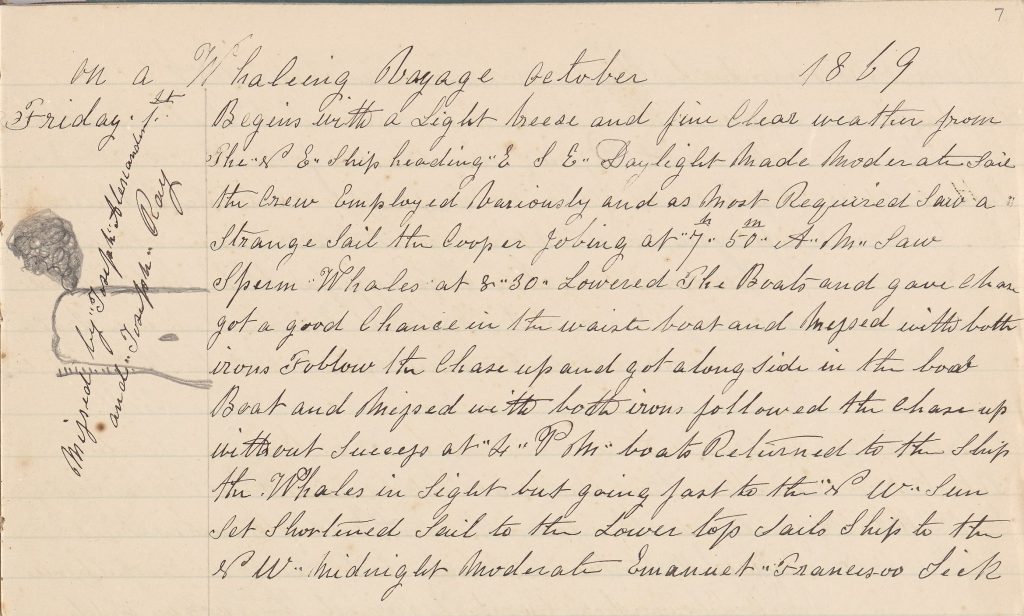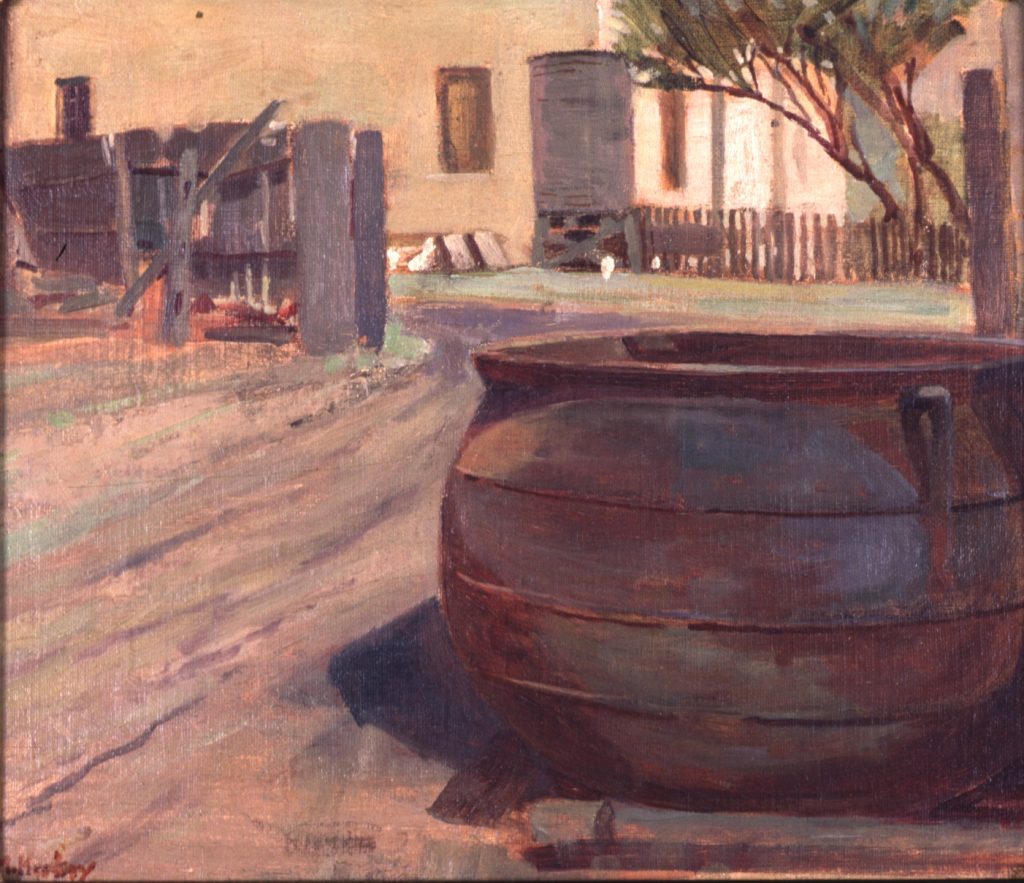Tasmania Reads: Reading an entry from the Log of the Whaling Ship Chance (Part Two: The Answer and Historical Background)

The State Library and Archive Service is issuing a challenge to Tasmanians to read five different examples of nineteenth-century handwriting from our Heritage Collections, each featuring a different set of records held in the State Archives.
Just to recap:
Your Transcription Challenge

The Answer
On a whaling voyage October 1869
Begins with a light breeze and fine clear weather from the “NE” Ships heading “E S E” Daylight made moderate sail the crew employed seriously and as most required saw a strange sail the Cooper Febring at 7.50 A M saw Sperm Whales at 830 lowered the boats and gave chase got a good chance in the waist boat and missed with both irons Foblow the chase up and got along side in the bow boat and missed with both irons Follow the Chase up and got alongside in the boat and missed with both irons followed the chase up without success at 4pm boats returned to the ship the whales in sight but going fast to the NW sun set shortened sail to the lower tops sail ship to the NW Midnight moderate Emmanuel Francis Sick
[Diagonal text] Missed by Joseph Alexander and Joseph Ray
Historical Background: A Short Introduction to Whaling in Tasmania
Tasmania has long been the natural habitat for numerous species of whale. At one stage the whaling industry was one of the biggest in the Colony. Demand for whale-based products was high – whale oil was essential for lighting and industrial purposes and even the construction of clothing – until overfishing and changes in product demand saw it gradually disappear. Echoes can still be felt today – A prominent historic waterfront pub is called ‘The Whaler’, Old rendering pots can still be seen in local parks, and diverse materials can be found in local collections.

The initial development of the Whaling Industry in Tasmania was around shore-based stations. It is said that in travelling up the Derwent soon after the European Settlement was established, Reverend Knopwood said that he ‘…passed so many whales that was dangerous for the boat to go up the river unless you kept very near the shore’ (Robert Knopwood , The Diary of the Rev. Robert Knopwood,1805-1808 ) The lure of easy money ensured that the resource was soon generating income. Whales were easily located by lookouts operating from the shore. Upon seeing one a crew would set out with their harpoons, and if lucky, return the carcass to the shore for processing. Processing stations were developed in numerous locations including the Derwent, Adventure Bay, Recherche Bay, and Bicheno.

Later whalers began to move into the deeper seas, and this type of hunting became predominant. T.W. Sharpe describes the 1830s as the peak period for Tasmanian Whaling – for both the shore-based stations and in deeper seas. At this time Whaling made significantly more money than the Tasmanian wool industry. As the resource became over fished during the 1840s Shore based factories became less viable – but the deeper sea whaling flourished – with up to 37 whaling ships reported to be operating at one time.

This era of whaling may feel familiar to many readers, reflecting stories romanticised in popular culture, in such works as Herman Melville’s Moby Dick. Romanticisation was still evident in the early stages of the 20th Century as evidenced in this nostalgic statement from the Mercury’s 70th Anniversary Issue:
It is useless to regret, vain to wish back the old. The days of the old whaling industry are gone forever. There are many men in Hobart to this day – not many of them, it is true – who served in those old whalers; men who remember the time when Hobart Habour was full of whalers flying different flags, and Prince’s Wharf was stacked high with the rich casks of oil. They were indeed great days, those days of a bygone era, when swarthy ear-ringed men from Mediterranean lands mixed in the streets with fair Norsemen from the North, and all was merry with wine and song when the homeward-bound whaler came flag-bedecked into port.
The Mercury, July 5, 1924, p.57.

In the latter stages of the 19th Century new technologies, such as electric lighting, developed. These made the whale products less necessary – and the industry began to decline. There had also been little regard paid to the management of the resource – resulting in a sad decrease in whale numbers. The last whaling ship is said to have left the port of Hobart in 1900. (Kathryn Evans, ‘Whaling’, Companion to Tasmanian History, 2005)
Our Collections
Whaling Logs
Whaling boats kept official log-books – often updated by the first mate. The logs recorded information on location, local conditions, the well-being of the ship and crew, and most importantly the sighting and capture of whales.
The Crowther Collection at the State Library of Tasmania holds many examples of these logs, providing straightforward information on the voyage but sometimes becoming much more evocative documents of the time.
Many of our logs have been digitised and can be read on the internet. Those that haven’t yet been photographed are accessible through the History Room at the State Library of Tasmania. Have a look at some of our holdings here: Search – Tasmanian Archives (sirsidynix.net.au)
Scrimshaw
Scrimshaw is a decorative art form that involves etching upon bone or ivory. It was thought to have been developed by Whalers utilising the by-products of their catches – to keep themselves entertained in their down time on board ship. Images were often initially sketched onto the teeth or bone, and then inscribed using needles and other fine tools. Finally, ink of some form (possibly soot or tobacco juice) was rubbed into the scratches, providing contrast for the image.
The subjects for the images were varied. Some common topics included life at sea and nautical themes, whales themselves, classical myths, sweethearts, and bouquets. Inspiration was often taken from popular publications of the time. The pieces give us a wonderful insight into the imaginations and thoughts of the whalers – artists with no professional training. A self-taught art, it allows us some insight into the everyday thoughts of regular sailors – in contrast to the highly curated art generally seen in galleries and museums.
The State Library has a comprehensive collection of Scrimshaw, with forty-eight items held in the Crowther Collection.
Some of my favourite items are:
Highlander and Victim atop a crag:

Sperm Whaling in the South Pacific Ocean:

Regal lady with Eagle on draped cloth canopy:

Lending Material
Whaling has long been an intriguing topic explored by novelists, historians, artists, and film makers alike.Libraries Tasmania hold many whaling related items – not only in reference collections. The following items provide just a taste of what we hold – and all available to borrow and enjoy from home:
Susan Lawrence, Whalers and Free Men: Life on Tasmania’s Colonial Whaling Stations (2006)
A detailed description of life in the coastal camps – where shore-based whaling was based. The book provides interesting detail on the day to day lives of the whalers, pieced together from archaeological excavations.
Steve Paszkiewicz and Roger Schroeder, Scrimshaw – a complete illustrated manual (2005)
This book provides an ideal starting point for those interested in learning more about or trying to create their own scrimshaw. The book details the history and basic techniques of the form, as well as providing patterns to use in your projects.
Herman Melville, Moby Dick (1851)
Herman Melville’s epic narrative of men and whaling which is often regarded as one of the most significant works of American literature. The novel conjures vivid images of the logistics of deep-sea whaling – in addition to a complex narrative that is open to a range of interpretations.
The North Water – DVD (2021)
A brooding historical television drama set in the world of whales and whaling in the 1850s (based on a novel by Ian McGuire). The series descries the events aboard a whaling boat that ventures into Arctic waters. It isn’t specifically Tasmanian but gives a picture of life on a whaling boat in this era – albeit with slightly more murder than may have been usual! Starring Colin Farrell as Henry Drax, an intimidating harpooner.
A Short Bibliography
Knopwood, Robert, The Diary of the Rev. Robert Knopwood, 1805-1808, (Hobart: Government Printer, 1947).
S Chamberlain, ‘The Hobart whaling industry’, (PhD Thesis: La Trobe University, 1988).
M Nash, The bay whalers: Tasmania’s shore-based whaling industry, (Canberra: Navarine Publishing, 2003).
Jameson, Marian, A Guide to Scrimshaw in Tasmanian Collections and the legacy of Sir William Crowther, (Hobart: 1998).
Meyer, Charles Robert, Whaling and the art of scrimshaw, (New York: H.Z.Walck, 1976).
Alexander, Alison (Ed.), The Companion to Tasmanian History, (Hobart: University of Tasmania, 2005)
Archives Office of Tasmania Research Files (found in the Tasmanian Names Index)
Thanks for the transcription challenges.I am enjoying them very much.However,I’ve noticed a few small errors in the transcription results.
Re #2.The original document reads “afterwards Moses”.There is no “as” between these two words.Perhaps it’s a mis-reading of the ‘ds’ ending of ‘afterwards’.
Re #3.The word “Friday” at the top of the margin was not transcribed and in the sentence mentioning the employment of the crew the word “variously” was transcribed as “seriously”.(Compare the ‘v’ with “voyage”.)
I hope this is helpful,
regards,
Richard Barrett.
A follow up for those interested in Scrimshaw. The current exhibition at Narryna Heritage Museum (Battery Point) is Women and Whaling. In addition to art works depicting individuals who invested in whaling and their ships, there are dresses and corsets strengthened with whalebone or baleen, perfume bottles and a piece of ambergris (from sperm whales – an ingredient of some perfumes to this day), crochet hooks, knitting needles, tatting shuttles, a ‘swift’ for winding thread, pastry wheels…. and of course many pieces of scrimshaw.
On the transcription: I would suggest the crew were employed VARIOUSLY, not seriously – the letter V used at the start of the word is very different from the S’s used – eg in Sperm, strange, sail…..
Thanks Alex, love the way you are using the platform of Tasmania Reads to not only shed a light on the material we hold at the State Library in terms of handwritten text and the challenges in transcribing same but also then sharing additional works in the Collection that relate to the topic – great read, thank you.